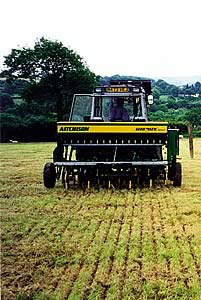| 12/03/09
Underperforming pastures are a significant risk this spring and beyond for many livestock farmers if action isn’t taken to rectify the effects of an exceptionally damaging winter period, according to Helen Mathieu of British Seed Houses.
Surface seeding.
 |
Increased autumn disease challenge, excessive rainfall and a lengthy period under snow are the main factors that have left swards depleted and drained of nutrients, she says, and a clear strategy will be needed if farms are to make the most of their forage acres this season.
Assessing sward content and soil nutrient status should be the first actions, as this will allow the correct plans to be put in place.
“It is important to test soil nutrient status as a starting point, because even if swards are in good condition they will require the correct levels of fertilisation to achieve optimum performance,” advises Helen Mathieu. “It may be that the very wet winter has caused more nitrogen leaching than would be normal, so be prepared to rectify this with increased applications if necessary.
“Alternatively, swards may be depleted, with fewer sown species present and a great proportion of weed species. Leaf diseases like crown rust are becoming more common and will leave swards more susceptible to winter damage, whilst poaching may have been more of a factor in a wet season and frost will have done little to improve survival rates.
“Whilst a complete reseed remains the best way to establish a new sward, spring overseeding should be considered as an option that will minimise the time out of production. Another very effective approach would be to grow a brassica break crop over the summer to keep the forage acres performing and then carry out a full reseed in the autumn.”
Helen Mathieu’s advice in relation to overseeding is again to ensure that soil nutrient levels are adequate and also to wait until surface soil temperatures are at least 6°C and ideally up to an optimum of 8°C. Whatever the method of overseeding, good seed-to-soil contact will be a key factor in ensuring good establishment.
Brassicas such as the rape/kale hybrids Swift or Redstart are an ideal catch crop ahead of autumn reseeding, providing good levels of nutritious grazing over summer as well as a weed, pest and disease break.
“Pasture can be grazed up to the end of April and then shut up to allow 15-20mm (6-8 inches) of growth to develop,” recommends Helen Mathieu. “Then spray with glyphosate and either cut or graze heavily before scratching in or direct drilling the brassica seed in May or early June. This will produce a high quality grazing crop in 8-10 weeks and allow time for utilisation before ploughing up for a full high quality reseed from late August.”
 New Wynnstay Store Opens its Doors in Leominster New Wynnstay Store Opens its Doors in Leominster
 Barenbrug's Barmix Gets the Thumbs Up after Trial Barenbrug's Barmix Gets the Thumbs Up after Trial
 Bumper Rice Harvest Could Ease Consumer Prices Bumper Rice Harvest Could Ease Consumer Prices
|


